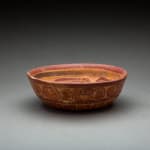Mayan Copador Polychrome Bowl, AD 300 - AD 900
Ceramic, Pigment
5.4 x 16.3 cm
2 1/8 x 6 3/8 in
2 1/8 x 6 3/8 in
LR.020
Further images
The majority of the painting on this vessel is dedicated to a sequence of glyphs. A swirling wave-like glyph repeated three times fills a band on the interior rim of...
The majority of the painting on this vessel is dedicated to a sequence of glyphs. A swirling wave-like glyph repeated three times fills a band on the interior rim of the bowl. This glyph is attached on the left to another glyph that looks like the letter “C.” Various black and red rings frame this band of Mayan text. The exterior is decorated by an upper band of glyphs, while the lower half of the body is adorned by a pattern of orange vertical rectangles that seem to radiate from the center like the petals of a flower. The wave glyph is repeated in the exterior not paired with a glyph in the form of a stylized face with a most prominent red eye. These glyphs are now attached to another one that resembles the number “3.” What was the relationship between these symbols? What do they stand for? There was a level of sophistication achieved in the Mayan alphabet that, unfortunately, we are unable to fully comprehend its subtle intricacies. Discovered inside of a tomb, buried alongside a fallen ruler or dignitary, this vessel was as essential in the afterlife as it was in this world.
1
of
67





